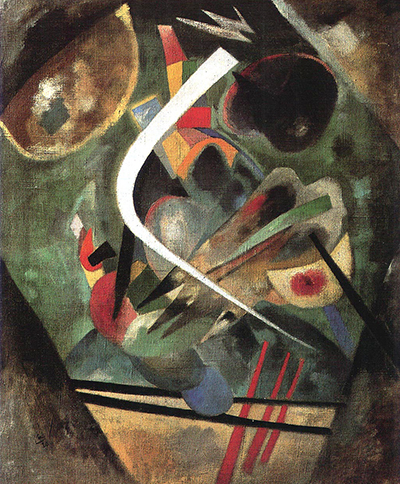White Line is a lesser known artwork from the career of Russian abstract artist, Wassily Kandinsky. The painting is dated at 1920, a time of great experimentation for the artist.
We find the single white line sweeping its way through the centre of the composition. It is a pure tone that is never intended to merge in anyway with the rest of the work. It is perhaps unusual for Kandinsky at this stage of his career to leave one element so contrasting with the rest, although he did also like to use tones of deep black that had a similar impact elsewhere. The main background is green with gold at the bottom, and all four corners have edges squared offer by darker regions. It feels almost like staring through a clearing within a forest, though the content that sits in the centre is hard to compare with anything from reality. There are all manner of different shapes merged in together in a seemingly organic composition, akin to something you might see within science fiction. There are also three thin spikes in red, with two in black intersecting them near the bottom of the canvas.
Kandinsky went through important changes leading up to this painting of 1920. By the time that White Line had come along he had already switched from his landscape art towards alternative ideas which were not far more disconnected from reality. Whilst always having a preference for abstraction, his work was still rooted in reality until around this point when things progressed onwards, just as you will find in the careers of other artists who went on a similar path, such as Mondrian and Miro. He left behind an exciting and inspiring oeuvre which holds great depth because of these variations in abstraction, and his output totalled into the hundreds by the end of his career in the 1940s, by which time his legacy was assured.
The painting can now be found at the Museum Ludwig in Koln, which most know as the city of Cologne in the western most part of Germany. The institution specialises in contemporary art, making Kandinsky's appearance particularly suitable because of how he also spent so much of his career living in Germany. You will find a number of other notable artworks on display here, including August Macke's Lady in a Green Jacket from 1913. There are also a number of paintings from Kazimir Malevich too. The likes of Natalia Goncharova, Ernst Ludwig Kirchner, Salvador Dali and Josef Albers are also featured here and it remains one of the best collections of modern art to be found in all of Germany. It is also continuing to expand its selection of works, meaning future visits would be well worthwhile.




